 Torres del Paine!
Torres del Paine!
 Torres del Paine!
Torres del Paine!

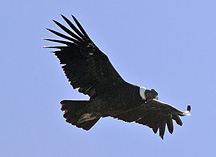 Anyone
familiar with spectacular landscapes knows the name - Torres del
Paine, the Towers of Paine. The ruggedness of the mountain landscape
and the unsettled, stormy weather conjures up a variety of mental
images, no doubt fostering the mistaken belief that the English
translation of Torres del Paine is the Towers of Pain! Of course,
for anyone who has ever tried climbing the towers, pain might
be the best translation.
Anyone
familiar with spectacular landscapes knows the name - Torres del
Paine, the Towers of Paine. The ruggedness of the mountain landscape
and the unsettled, stormy weather conjures up a variety of mental
images, no doubt fostering the mistaken belief that the English
translation of Torres del Paine is the Towers of Pain! Of course,
for anyone who has ever tried climbing the towers, pain might
be the best translation.
In December of 2002 I did an exhaustive and intensive scouting
trip of the southern Andes, including locations in southern Argentina
and Chile. The climax of the trip was undoubtedly Torres del Paine
National Park in southern Chile. Although I was familiar with
innumerable images of this spectacular mountain, and to a lesser
extent with images of the guanacos - the llama-like herbivore
that is one of four Western Hemisphere species most closely related
to the Old World camels - I was surprised at how accessible several
species of mammals and birds were for photography, and even more
so, how diverse the landscape potential proved to be.
In December of 2003 Mary and I traveled to Torres del Paine on
our own. We not only went so that I could show her the park and
the incredible scenery but we also went to try and work on pumas,
the elusive cat that haunts wilderness areas from Chile to Canada.
In addition I wanted the two of us to check out all of the logistics
for bringing a group to this area. We weren't successful with
the pumas but on that trip we met an enthusiastic young photographer,
Diego Araya, who lives and breathes the park and who turns out
will be our private guide for this trip.
In short we was very impressed with the park, and the relative
ease one enjoys in shooting the diverse landscapes and wildlife.
In many ways Torres del Paine National Park reminded me of Denali
National Park in Alaska. Both are dominated by a prominent mountain
feature, which is sometimes obscured by clouds. The surrounding
landscape is similar as well, for both look tundra-like, but unlike
Denali's often wet tundra and thick clusters of willows and blueberry
bushes, Torres landscape is dry, almost brush free, and quite
easy to hike through.
More importantly, there are no road restrictions in Torres, and
private vehicles are free to come and go at their own schedule
to stop and photograph at will. This, I found, was the biggest
difference between these two parks, for access was not a problem
in Torres. If you have photographed in Denali, you know that situation
- and the compromises involved in using the buses.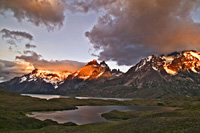
Again contrasting with Denali, several roads traverse Torres,
providing multiple views of the chocolate-colored 'horns' or the
glowing granite spires of the towers that dominate the mountain
landscape. Two quite different views characterize the mountain
landscapes of Torres del Paine. Perhaps the most common view depicts
what are referred to as the 'horns, steep sided cliff faces reminiscent
of the granite cliffs of Yosemite that are topped with a dark
brown layer of sedimentary rock. Hanging glacial valleys, the
horns, and a panorama of snow-capped mountains on either side
characterize this view, which is visible from most of the roads
and overlooks inside the park. The actual 'towers,' the Torres
del Paine for which the park is named, are less accessible. Three
granite towers, or spikes, line the eastern edge of the Paine
Massif, and these are most easily seen from eastern vantages.
Although great dawn color is possible from both the 'horns' and
the 'towers,' the 'famous shots' of Torres del Paine are of the
towers. We'll be within view of the towers on several of shooting
days, so we should have ample opportunity to document all aspects
of the park (weather permitting). Roads and ferries offer vantages
for glaciers and mountain views. This access provides tremendous
latitude in our shooting, allowing us to capitalize on the best
shooting opportunities as light and weather permit. This access
also makes a one-week trip the perfect time frame for filming
the park!
 Like
many mountain environments (including Denali), Torres del Paine
can have unsettled weather, and it is possible that an entire
week, or an entire month, elapses without presenting an opportunity
to see or to photograph the mountaintops. Unlike Denali, however,
where weather systems may advance from the warm Pacific current
and remain for days, most weather systems in the far windier Torres
last for hours. From spring through fall it is possible, and not
at all unlikely, to experience virtually every type of weather,
and season, Torres experiences - in a single day! While snow is
unlikely at the elevations we'll be visiting, snow or freezing
rain could occur. Just as likely, however, are warm days where
a windbreaker or long-sleeved shirt is all that is required.
Like
many mountain environments (including Denali), Torres del Paine
can have unsettled weather, and it is possible that an entire
week, or an entire month, elapses without presenting an opportunity
to see or to photograph the mountaintops. Unlike Denali, however,
where weather systems may advance from the warm Pacific current
and remain for days, most weather systems in the far windier Torres
last for hours. From spring through fall it is possible, and not
at all unlikely, to experience virtually every type of weather,
and season, Torres experiences - in a single day! While snow is
unlikely at the elevations we'll be visiting, snow or freezing
rain could occur. Just as likely, however, are warm days where
a windbreaker or long-sleeved shirt is all that is required.
Last year within an hour's time we went from a beautiful, rosy-colored
sunrise with puffy clouds to a totally cloud-obscured mountain
with winds that were howling so strongly that Mary and I could
literally 'sit' into the wind and be held up by the gale-force
blow. As the front came in and snow and rain showers hit the area,
single, double and triple rainbows danced across the valleys in
front of the mountain. It was a spectacular changing landscape
that took every ounce of our strength and concentration to shoot.
As the clouds cleared later that day the mountains were covered
with fresh snow giving us once again a different look at these
impressive rock shrines.
Our trip is planned for the peak of the Austral summer, when wild
flowers, verdant vegetation, and wildlife babies will be at peak
abundance. Despite the infamy of Torres winds, I did some outstanding
wildflower and close up photography on my first visit - it isn't
always windy, and there are many sheltered pockets where there
is no wind at all. Last year we also had some relatively calm
days where macro photography and wide-angle scenics were possible.
 December
is the birthing and mating season of the camel-like guanacos.
Tenacious shooters willing to 'hang in there' with a herd may
be treated in witnessing, and filming, a guanaco birth. We missed
several by less than 10 minutes on our scouting trip! Baby guanacos
are incredibly cute - fuzzy big-eyed critters vaguely resembling
a pony - and the animals are curious and tame, making portraits
a fairly easy endeavor. Females mate again within a few days of
giving birth, so December is prime not only for romantic images
of mating guanacos, but also affords the possibility of filming
heated fights between males defending territories or squabbling
over mates. Young males, anxious to test their strength, fight
frequently, and it's fairly common to see these play-fights up
close.
December
is the birthing and mating season of the camel-like guanacos.
Tenacious shooters willing to 'hang in there' with a herd may
be treated in witnessing, and filming, a guanaco birth. We missed
several by less than 10 minutes on our scouting trip! Baby guanacos
are incredibly cute - fuzzy big-eyed critters vaguely resembling
a pony - and the animals are curious and tame, making portraits
a fairly easy endeavor. Females mate again within a few days of
giving birth, so December is prime not only for romantic images
of mating guanacos, but also affords the possibility of filming
heated fights between males defending territories or squabbling
over mates. Young males, anxious to test their strength, fight
frequently, and it's fairly common to see these play-fights up
close.
Last year we also found a rather tame group of Patagonian gray
fox near the one ranger's station. The fox den at this time of
year and if we're lucky we could find pups waiting at the den
site for their parents to bring back scraps of food. Mary and
I found two different dens one of which, with a little patience,
produced some great images.
December is the prime month for birds as well, and most species
have young or our sitting on nests at this time. Swans (2 species),
ducks (several species), grebes (3), coots (2), shorebirds, songbirds,
and birds of prey are seen almost daily, although exactly what
we'll see or film depends upon the year and our group's luck.
But just to get you a little excited on the possibilities, Mary
and I spent almost two hours last year photographing black-necked
swans with cygnets as close as twenty feet at times. We got shots
of the adults feeding their chicks vegetation plucked from beneath
the water's surface, of different pairs of adults chasing each
other and of cygnets riding the back's of their parents. And all
of this while just sitting along the shoreline without a blind!
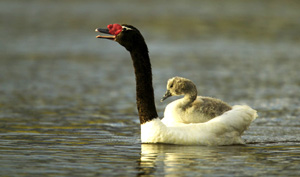 This
trip is a 'tour,' where our daylight hours will be involved in
finding, and filming, subjects. Unlike our workshops where we
conduct compositional exercises and offer review quizzes and instruction,
we'll be using our daylight hours solely for photography.
This
trip is a 'tour,' where our daylight hours will be involved in
finding, and filming, subjects. Unlike our workshops where we
conduct compositional exercises and offer review quizzes and instruction,
we'll be using our daylight hours solely for photography.
That does not imply that we're not available to help you in whatever
ways we can. Mary and I will be offering our on-the-spot suggestions
on the best way to compose the images before us, as well as suggestions
on making the correct exposures, choosing the correct lenses,
and obtaining the best perspectives. We're always there for you
-- if you have questions, if you'd like an opinion on a composition,
if you'd like to see what we're doing, whatever, WE ARE THERE
FOR YOU. On a tour, we too will be shooting but we'll be with
you, orchestrating the shoot to provide the best opportunities
for our group. We won't disappear and let you to your own luck,
although we also won't 'hang around the car' with those less motivated.
We'll be there to film, hopefully side by side with all of our
participants, and we hope that everyone will share that same enthusiasm
to photograph.
The landscapes of Torres del Paine, however, offer a special opportunity
for photo instruction, and we'll be taking advantage of this.
We would suggest anyone who has access to Tilt/Shift lenses bring
one or more along. Graduated Neutral Density Filters will be especially
useful here, as well as a new technique I've been employing -
Digital Compositing, where two images are made from a single tripod
position and exposures are set for both high lights and shadows.
In a computer (either via direct import from a digital camera
or at a subsequent date via a set of scanned slides) the two images
can be merged into one to provide a rendering that most closely
approximates what our eyes and human perception truly sees. We
will be demonstrating this technique on our laptop and explaining
the methods of doing so in the field - a technique I find invaluable
for shooting landscapes with contrasting elements.
Finally, we're available to answer all of your questions prior
to the trip, and we'll be anxious to assist you in your efforts
when we're afield in Torres del Paine.
December in southern Chile involves long days. Our trip will
end just days before the longest day of the year in the southern
hemisphere, and at our southern latitudes true darkness extends
from approximately Midnight until 4AM. Our shooting schedule will
vary each day, but our sunrise shoots (when sunlight actually
reaches the mountain tops and provides light for our subjects)
typically begin at around 5:45AM, and late evening shooting in
the field extends to 9PM. Our hotel base is located in one of
the most scenic locations in the park, and photographers who wish
to shoot even later from the hotel's grounds may do so - at least
until10PM or so!
 You
might wonder, based upon the above facts, when someone sleeps
or eats while filming in Torres del Paine! On at least two of
our days afield we'll be shooting sunrises from our hotel's location,
so we'll be able to have a great cooked breakfast at the hotel.
On some mornings we'll be shooting sunrises from more remote locations
and on those days we'll either have our breakfast with us or we'll
have a late brunch that may cover breakfast and lunch (although
lunch will still be available at the hotel should we return during
meal times). Normally our lunches will be a very pleasant 'picnic
style' field lunch featuring a variety of meats, cheeses, salmon,
fruits, etc. - quite tasty, I can tell you. Dinners will be eaten
at our hotel - which will require our returning by 9PM or so,
although shooters can still squeak out some telephoto extractions
of the 'horns' before, during, or after dinner.
You
might wonder, based upon the above facts, when someone sleeps
or eats while filming in Torres del Paine! On at least two of
our days afield we'll be shooting sunrises from our hotel's location,
so we'll be able to have a great cooked breakfast at the hotel.
On some mornings we'll be shooting sunrises from more remote locations
and on those days we'll either have our breakfast with us or we'll
have a late brunch that may cover breakfast and lunch (although
lunch will still be available at the hotel should we return during
meal times). Normally our lunches will be a very pleasant 'picnic
style' field lunch featuring a variety of meats, cheeses, salmon,
fruits, etc. - quite tasty, I can tell you. Dinners will be eaten
at our hotel - which will require our returning by 9PM or so,
although shooters can still squeak out some telephoto extractions
of the 'horns' before, during, or after dinner.
OK, that implies that our days begin somewhere before a 5:45AM
sunrise shoot and end post-9PM dinner (10 PM or later being realistic).
So, when does one sleep?
Siestas! On several of our days during the scouting trip we returned
to our hotel between 1PM and 3PM and rested, usually getting in
at least an hour nap, and sometimes more, before leaving again
at 6PM for our evening shooting. From our centrally located hotel
we're less than 45 minutes from all the great afternoon shooting
spots, and literally minutes from some, and I found a 6PM departure
(most days) for the evening shoot worked out perfectly. Of course,
for some shoots we may need to leave earlier….
Our daily activity is generally not very strenuous. Unlike Denali
where photographers are often dropped off at a location and picked
up hours later (requiring you to carry all the gear you think
you'll need), we'll have our vehicle accessible at all times.
Much of our shooting will take place within a few hundred yards
of any road, and only one shoot will require an easy walk of over
one hour (and that's worthwhile only on a clear sky day). There
are other short hikes that will take us to different vantage points
of the mountains and depending on weather and timing, we may do
some of these as well.
Of course, if we're following guanacos (usually close to the road),
or foxes, or pumas (yes, that is possible!) we might be walking
for miles, but that's the exception not the rule. Hiking through
the landscape was easy - the regular trails were very good and
when we went 'back country' the hard, desert-like terrain made
for very easy walking.
Unlike many exotic destinations, it is quite easy to 'do' Torres
del Paine in a five-day shooting schedule. Even with bad weather
(where the mountain tops are obscured), in a five day time frame
the likelihood is high that the skies will open up, or the clouds
will lift, and the classic Torres del Paine shots will be available
(I wouldn't place an equal bet on those types of odds for Denali).
On my scouting trip I had great weather, and clear skies, almost
continually, so much so that I had relatively few chances at the
dramatic lighting and cloudscape/mountain views Torres del Paine
is noted for. Last year we did have more dramatic skies and we
took advantage of these situations at every turn.
At some time during the week we'll take the group on an all-day
trek to the Lago Grey area. We'll board a boat for the four-hour
roundtrip cruise that will take us to Grey's Glacier. We'll cruise
along both fronts of the calving glacier and enjoy incredible
scenery along the way. Last year the boat pulled right up to a
floating iceberg that was the most spectacular color of blue I
have ever seen. One of Joe's shots of the detail and patterns
in the ice was entered into this year's BBC photo contest. While
in this area we'll look for the endangered huemel deer and the
very colorful Austral Parakeet and the ruckus Magellanic woodpecker.
At different times of the day light dances off of the icebergs
that eventually ground themselves along the shoreline of the lake.
The road leading to the lake offers the best grand view of the
entire Paine Massif that we will encounter in the park.
Further, aside from grand mountain landscapes, Torres del Paine
has a relatively limited number of subjects (at least as compared
to some of our other destinations). I felt that my five days in
Torres was quite adequate, unless I was going to devote concerted
time on filming guanaco behavior or attempting to find, and photograph,
a puma. According, we've made this a 5-day in the field shoot.
Here's the details:
Day 1, Friday: December 10. Leave the US in late evening.
Flights via American Airlines and Lan Chile depart from Dallas,
Miami, and Los Angles.
Day 2, Saturday: December 11. Arrive in the early AM in
Santiago, Chile, and after a short lay-over you'll be taking a
Lan Chile domestic flight to Punta Arenas. Normally we would suggest
staying in Santiago overnight but domestic airlines typically
impose luggage weight restrictions that are more limited than
allowed for US passengers. By flying non-stop, you'll be under
US luggage weight allowances, which are the most generous. Overnight,
Hotel Isla del Jorge, Punta Arenas.
Day 3, Sunday: December 12. Depart for Torres del Paine
via our land vehicle. We'll stop for gas and lunch in Puerto Natales
along the way. The driving time, non-stop, to Torres del Paine
is approximately 5 hours, and we'll be arriving at our hotel,
the Hosteria del Pehoe, in the center of the park by early evening,
in time for a sunset shoot if we desire. As we near the park we'll
get our camera gear ready for shooting ops along the way. Overnight:
Hostería Pehoe.
Day 4, Monday: December 13 - Day 8, Friday: December 17.
We're not going to set a definite itinerary for these five days.
It was our experience that even the best laid plans never materialized
due to the changing weather conditions. But here is a list of
things that we plan to accomplish during our five days in the
park. Overnights: Hostería Pehoe.
Sunrise shoots will be either from our hotel location or from
some other vantage point in the park. Many of our sunrise locales
are in the eastern part of the park looking back toward the Towers
with Lago Nordenskjöld in the foreground. Depending on weather
conditions there are several other sites to the south and west
where we can photograph the changing light of sunrise, or sunset,
on the mountain. At least one of the mornings, we'll head out
early in hopes of seeing a puma, or mountain lion, walking across
the Patagonian landscape. Puma country encompasses some of the
best sunrise locales in the park so we won't be going out of our
way in trying to catch a glimpse of this park predator. We'll
have a mix of field breakfasts and cooked breakfasts depending
on the days planned activities.
On one of the days after breakfast we'll head to the Grey's Lake
area while on another day we'll head toward Lago Azul for a great
viewpoint of the 'towers' of Torres del Paine, where we'll have
a wonderful cooked picnic brunch. The area around Lago Azul (that's
Lake Azul) is excellent for birds, and we may have an opportunity
to see or photograph Magellanic woodpeckers (the world's largest
species), Austral parakeets, Austral pigmy owls, and a variety
of water birds. The southern beech forest here is one of the best
in the park and there's a good assortment of wild flowers in the
area. Along the way we could encounter large herds of male guanacos
and will hopefully film these males chasing and fighting each
other. We'll also stop along the way to photograph the Cascades
of Paine with the Towers of Paine in the background.
On other days we'll head into the eastern area of the park to
look for Patagonian gray fox, marsh and water birds, guanacos,
and more scenics. There are several early morning scenic views
of the towers of Torres del Paine in this area including a river
view which would provide shooting opportunities for early morning
light on the actual Torres, or towers, as well as shots incorporating
reflections and flowers as the morning light floods the valley
before us. If there's an interest we'll attempt another pre-dawn
puma hunt before continuing to our planned destination. En route
to our Torres viewpoint we'll be passing through an excellent
area that can provide shooting opportunities to film guanacos
against the mountains and the towers, We'll also be passing through
great rhea (flightless birds similar to ostriches) areas.
We'll visit one of the prettiest landscapes we found within the
park, an area we dubbed the 'Japanese Garden' for the rich color
and beauty it offers. The moorlands around this area provided
some of the best flower photography in the park, with one, the
unique Porcelain Orchid, being especially abundant in the area.
We'll have a mix of picnic lunches in the field or lunches at
the hostería, On some days we'll head back to the hotel
for a siesta while other days will be spent entirely out in the
field. Afternoon shoots will be similar to morning shoots with
a little more concentration on specific species. As the week progresses
the day's shoots will be planned.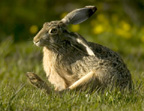
Gauchos! Patagonia's legendary cowboys will be the focus of our
attention on one of the mornings. Depending upon the weather and
the gauchos' schedules we'll probably do a sunrise shoot en route
to our shooting location where we'll photograph the gauchos leading
a herd of horses across the high pampas, with the Torres del Paine
mountain range as our backdrop. The gauchos will be authentically
dressed and we'll have multiple opportunities to photograph the
men, the horses, and the herding as they drive the herds passed
our position for our shooting. Afterwards we'll join the gauchos
at the corral where we can do candid portraits and shots as the
gauchos prepare the horses for the day's events. After the Gauchos
we'll continue on our quest for wildlife and scenics, perhaps
stopping for breakfast at the Hotel (depending upon time) or simply
continuing with our picnic breakfast to explore other parts.
 We'll
head back out (if we are at the hotel for a siesta) in the late
afternoon (5-6PM) to commence our evening shoots. We'll have to
play it by ear in regards to shooting sunset itself. An earlier
dinner (around 8PM) might be in order one of the nights to ensure
our getting in place for alpine glow. At other times, we'll return
to the hotel for a late dinner around 9PM. Sunset shoots are less
predictable due to the weather so our evening shoots will truly
be a work in progress each day. On Friday evening, since we are
leaving Torres del Paine National Park for our return to Punta
Arenas early the following morning, we'll have an abbreviated
evening shoot so that we can pack in preparation for our flight
home.
We'll
head back out (if we are at the hotel for a siesta) in the late
afternoon (5-6PM) to commence our evening shoots. We'll have to
play it by ear in regards to shooting sunset itself. An earlier
dinner (around 8PM) might be in order one of the nights to ensure
our getting in place for alpine glow. At other times, we'll return
to the hotel for a late dinner around 9PM. Sunset shoots are less
predictable due to the weather so our evening shoots will truly
be a work in progress each day. On Friday evening, since we are
leaving Torres del Paine National Park for our return to Punta
Arenas early the following morning, we'll have an abbreviated
evening shoot so that we can pack in preparation for our flight
home.
Day 9, Saturday: December 18. We'll be leaving our hosteria
at approximately 6:30AM, eating breakfast before we depart and
arriving at Punta Arenas by noon. We'll be taking an early afternoon
flight back to Santiago and connecting (with a few hour lay-over)
with our evening flight back to the US.
Day 10, Sunday: December 19. Arrive at your US airport
of arrival in the early morning, connect with your domestic flight
for your return home. Depending upon your connections you should
be at your final destination (airport, at least) by mid-afternoon.
Your fee includes the tour, all meals, lodging (based on double
occupancy), and transportation based from one of several departure
points, including Los Angles, Dallas, or Miami. Your fee also
includes all tips for the Chilean guide and driver and for the
Hostería Pehoe staff.
Our field meals are served picnic style, and although they are
not elaborate they are very complete and nutritious. You won't
be hungry, we can assure you! Dinners, breakfasts at our Hostería,
and any lunches taken at the Hostería are included. Bottled
water in the field and all non-alcoholic beverages are included
(water is potable at the hostería). Alcoholic beverages
are not included in the price of the trip.
Transportation includes airfare from the US destination (International
departure from the cities listed above are subject to Lan Chile's
schedule and/or changes), domestic flights in Chile from Santiago
to Punta Arenas and return, and land transportation from Punta
Arenas to Torres del Paine National Park, and back, including
all travel within the park. Registrants will receive specific
international flight information, including departure and arrival
times into and out of the US, within a month of registering.
PLEASE NOTE: Part of your trip deposit includes monies to lock
in your international flight itinerary. This air ticket will be
non-refundable, non-transferable. If you would cancel from the
trip the ticket will be sent to you for future use (in most cases
you have up to one year after the original departure date to reschedule
a flight with the listed carrier or an affiliate). Please list
your name as it appears on your passport on the registration form
and indicate your departure city choice. Thank you.
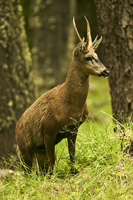 Transportation
in country is also included in the tour price. We'll be using
at least one large passenger van (at this point we anticipate
using a Mercedes Sprinter which can accommodate 9 passengers and
a driver, with two people per row of seats (this is a roomy vehicle!).
Our Chilean guide will be traveling with us in the Mercedes to
function as a scout or trouble-shooter when we're afield. A separate
vehicle will be part of our entourage while in the park and this
driver and our guide, at times, will proceed to pre-determined
spots to set up our field lunches or breakfasts.
Transportation
in country is also included in the tour price. We'll be using
at least one large passenger van (at this point we anticipate
using a Mercedes Sprinter which can accommodate 9 passengers and
a driver, with two people per row of seats (this is a roomy vehicle!).
Our Chilean guide will be traveling with us in the Mercedes to
function as a scout or trouble-shooter when we're afield. A separate
vehicle will be part of our entourage while in the park and this
driver and our guide, at times, will proceed to pre-determined
spots to set up our field lunches or breakfasts.
We strongly advise that you obtain trip/travel insurance if there
exists the remotest possibility that you may have to cancel at
the last minute or leave the tour before its conclusion on Saturday
morning. For those who register for the trip a travel insurance
application form will be sent with your acknowledgment letter.
Lodging is included, and is based upon double occupancy. We'll
do our best to make roommate matches. Please be aware that if
a roommate is unavailable (due to an odd number of males/females
or an odd number of registrants) you will be responsible for the
single supplement. Roommates will be assigned based on receipt
of the registration form and whether it is a male or female registrant.
The additional cost of the single rooming supplement is $590.
We are also checking into the possibility of offering a single
room to people for the first night in Punta Arenas. This option
is subject to availability and the cost is $116. There's a space
on the registration form to indicate if you are interested in
this option if it becomes available.
We'll be forwarding a complete list of equipment and film recommendations
to our registered participants. However, this tour offers the
wonderful chance to use a variety of different lenses, for telephoto
shots of wildlife or for landscape extractions, as well as wide-angles,
zooms, and tilt-shift lenses. Panoramic cameras are also useful
and fun to use on this trip.
Registered participants will be forwarded a complete list of suggested
equipment, film choices, and recommendations.
CLOTHING AND THE WEATHER
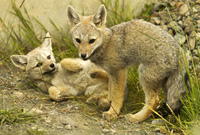 Weather
at the beginning of summer in Torres del Paine can be erratic,
ranging from a 'typical summer day' to nearly winter conditions.
Regardless, you can expect the mornings to be cool, and gloves
and a wool cap are suggested. On my scouting trip I typically
layered, with my most important clothing items being a windbreaker
(wind is a near constant) and a good pair of broken-in hiking
boots. We advise people to wear layers that can be shed as the
temperature increases or decreases. Although unlikely, we could
have heavy snow flurries, freezing rain, or damp fog, so we advise
people to pack for the type of field conditions one might experience
in Yellowstone in late September, just in case. Mary will provide
participants with a complete list of suggested clothing.
Weather
at the beginning of summer in Torres del Paine can be erratic,
ranging from a 'typical summer day' to nearly winter conditions.
Regardless, you can expect the mornings to be cool, and gloves
and a wool cap are suggested. On my scouting trip I typically
layered, with my most important clothing items being a windbreaker
(wind is a near constant) and a good pair of broken-in hiking
boots. We advise people to wear layers that can be shed as the
temperature increases or decreases. Although unlikely, we could
have heavy snow flurries, freezing rain, or damp fog, so we advise
people to pack for the type of field conditions one might experience
in Yellowstone in late September, just in case. Mary will provide
participants with a complete list of suggested clothing.
 Above
all else, this is a landscape trip. Mountain scenes will be dominant,
although the park affords so many more opportunities than merely
mountains. There are great beech forests, fairylands of goatsbeard
lichen, wonderfully patterned, lichen covered boulders, water
falls, lake scenes, ponds and reflections, and broad landscapes
that shows the interplay of light and shadow.
Above
all else, this is a landscape trip. Mountain scenes will be dominant,
although the park affords so many more opportunities than merely
mountains. There are great beech forests, fairylands of goatsbeard
lichen, wonderfully patterned, lichen covered boulders, water
falls, lake scenes, ponds and reflections, and broad landscapes
that shows the interplay of light and shadow.
Our trip will coincide with the peak of the wild flowers, and
the flowers, and pillow-like clumps of Mata Barrosa make great
foreground for mountain landscapes.
Wildlife is limited, compared to our trips to Africa or to western
US parks like Denali or Yellowstone. While we're almost certainly
going to film guanacos, a possibly a captive Andean condor, our
success with other species will depend on both luck and your own
efforts.Above all else, this is a landscape trip. Mountain scenes
will be dominant, although the park affords so many more opportunities
than merely mountains. Gray''s Lake and lagoon has a spectacular
assortment of stranded glaciers. Ever changing weather makes each
mountain scene unique.
There are great beech forests, fairylands of goatsbeard lichen,
wonderfully patterned, lichen covered boulders, water falls, lake
scenes, ponds and reflections, and broad landscapes that shows
the interplay of light and shadow. One can easily film landscapes
continuously here.
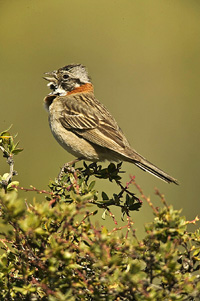 PROS AND CONS REGARDING THIS TRIP
PROS AND CONS REGARDING THIS TRIPPros:
1. The scenery is spectacular. In five days we'll have more than
enough time to visit every potential overlook for photographing
the mountains. If the weather cooperates we should have views
that provide clear, unobstructed views, as well as dramatic light
shots where clouds, snow, or mist shroud the horns or towers to
varying degrees. We are visiting the park at the peak time of
year, statistically, for good weather.
Cons:
1. The climate in this area is extremely variable - all four seasons
in a single day. It is possible that an entire week could elapse
without the mountains being visible.
Pros:
2. The wildlife is fairly tame, or absurdly tame in some cases.
Guanacos and Patagonian gray fox are especially cooperative, and
this park probably affords ones best chance of ever seeing a puma
in the wild. Bird life is unique, with approximately 100 species
in the park, and you're likely to see at least 40 species, and
perhaps as many as 60, including rheas, Andean condors, and black-necked
swans.
Cons.
2. The wildlife diversity is limited. Guanacos are the most easily
filmed animals, and great shots will entail spending time with
the herds so that behavior has a chance to happen. If you're impatient
and only wish to do snapshots, the chances are you'll not capture
fighting sequences, nursing, or births. While Patagonian foxes
are very tame (at tourist frequented areas), there is no guarantee
from year to year that foxes will be at a particular area. Seeing
a puma will be a matter of luck, and photographing one will be
unlikely, truly a matter of luck. Andean condors are seen almost
daily, and should, at some point in the trip, provide fairly good
photo opportunities if you are ready when one flies close by.
Pros.
3. We'll be visiting the park at what should be the best time
of year, weather and animal wise. Wild flowers should be in peak
abundance, providing close up and macro shots, as well as flower/scenics
via either T/S lenses or computer composites.
Cons.
3. Wind is a constant. Although there are times when there is
no wind, or windbreaks where the effect is limited, flower shooting
has to be done when the windows of still air appear. It could
rain daily, although the chances of this are slim.
Pros.
4. Our shooting days will be long - we'll be in the southern hemisphere
during their longest days of the year, and diners may not conclude
until after 10:30PM. Typically we'll take a siesta mid-day to
catch up on sleep!
Cons.
4. Our shooting days are long! If you don't want to miss out on
a sunrise shoot, or miss dinner, expect NOT to have a full 8 hours
sleep at one time.
Pros.
5. Torres del Paine National Park can easily be covered in a one-week
time, weather permitting.
Cons.
5. At the southern tip of the Western Hemisphere, Torres del Paine
is remote and a long distance to travel for a one-week trip. We
can provide alternative suggestions should you wish to spend more
time in South America, and can provide some contacts for side-trips
to Calafate and the Perito Moreno Glacier, or El Chitan and Mt.
Fitz Roy, or the Falklands, or Iguazo Falls, Argentina.
 Location: Punta Arenas and Torres del Paine
National Park, Chile.
Location: Punta Arenas and Torres del Paine
National Park, Chile.
Accommodations: Lodging is included. In Torres del Paine National
Park we'll be based at the most centrally located hotel, the Hostería
Pehoe, inside the park. Lodging is based on double occupancy with
a possible option for single accommodations in Punta Arenas pending
availability.
Photo Tour Duration: Our trip begins with our departure from our
US port of embarkation for Chile on Friday, Day One, and continues
until your return to our US arrival on Sunday, Day Ten.
Transportation: Included, to/from
our US departure cities of Miami, Dallas, or Los Angeles, as well
as transportation to/thru/from the park. If you cannot make our
group departure to Torres del Paine on Sunday, or if you are required
to leave the tour early, you will be responsible for transport
to or from the park at your expense.
Costs: $5,395, including all meals
in Chile, lodging (based upon double occupancy), transportation,
tips and all handouts. For our cancellation and payment schedule,
please see our registration sheet detailing it.
Participation: Limited to 6 participants.
Liability Release: Our release form
must be signed prior to participation.Location: Punta Arenas and
Torres del Paine National Park, Chile.
Accommodations: Lodging is included.
In Torres del Paine National Park we'll be based at the most centrally
located hotel, the Hostería Pehoe, inside the park. Lodging
is based on double occupancy with a possible option for single
accommodations in Punta Arenas pending availability.
Photo Tour Duration: Our trip begins
with our departure from our US port of embarkation for Chile on
Friday, Day One, and continues until your return to our US arrival
on Sunday, Day Ten.
My wife Mary Ann and I strive to provide the most comfortable,
enjoyable, and thorough shooting experience we think you'll ever
experience. Both Mary and I are photographers, and I'd hope you've
seen our credits. Our work regularly appears in National Wildlife,
Ranger Rick, Natural History, Living Bird, Birder's World, Wildlife
Conservation, and most nature/wildlife calendars.
I write a column, Focus on Big Game, for Outdoor Photographer
Magazine, and Mary and I are joint columnists for Joseph Van
Os's web magazine, Photosafaris.com. Additionally, Mary
and I are field correspondents for Nature's Best Magazine,
and photography columnists for Keystone Outdoors.
I hope you've seen some of our books. To date I've written seven,
A Practical Guide to Photographing American Wildlife; The Wildlife
Photographer's Field Manual; The Complete Guide to Wildlife Photography;
Designing Wildlife Photographs; Photographing on Safari, The New
Complete Guide to Wildlife Photography, and African Wildlife.
Mary's written twenty-seven children's books, including Woodpeckers;
Leopards; Grizzly Bears; Cobras; Boas; Pythons; Rattlesnakes;
Garter Snakes; and Flying Squirrels, and an adult book on the
Amish. Both Mary and I are at work on several new book projects.
Additionally, in 1994 Mary won two first place finishes in the
BBC Wildlife Photographer of the Year Competition, in Bird Behavior
and with Endangered Species, and won first place in the Professional
Humor Category in the Nature's Best competition in 1999 and first
place in the AGFA competition in 2003 in Mammal Behavior. In 2003
I won second place in the BBC competition with an image of male
lions lying amongst multiple tire tracks in The World in Our Hands
category..
More importantly, as photography instructors we are dedicated
to providing you with the help, instruction, and information you'll
need to have a most successful shoot. We're confident you'll enjoy
this experience and we hope that this shoot will be just one of
the many we will share together. In fact, many of our offerings
are filled with repeaters, and many of our extensive trips are
not advertised for this reason.